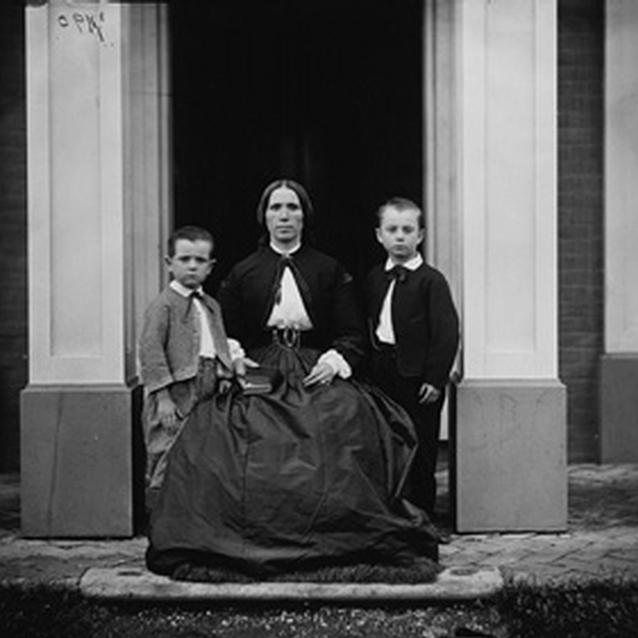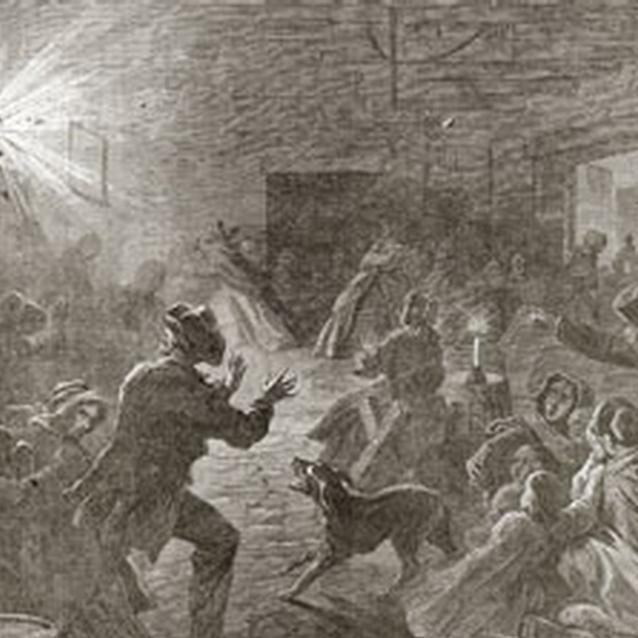The Union and Confederate armies moving through Maryland totaled almost 200,000 men. Some were veterans of horrible battles; compassion and sympathy drained from them by death and suffering. These men were suspicious of civilians and saw threats everywhere. Fearing the wrath of such soldiers and the violence that came with them, many civilians elected to evacuate their homes and avoid the possibility of confrontation. Refugees clogged the roads of Maryland; many of them women and children.
"The great objects in life were to procure something to eat and to keep yourself out of sight by day, and keep your candle light hidden by night; lights of every kind, being regarded as signals to the Rebels, were usually greeted by a volley of guns." Annie Marmion, young resident of Maryland
Civilian Children

Library of Congress
Most of the soldiers treated civilians with respect. Curious children were allowed to play among the men and ask them questions. They often exchanged gifts, sharing gentle moments in terrible times.
Five-year-old Cecilia was in the care of her aunt and uncle on a little farm near Fox's Gap in September of 1862. Realizing battle was imminent; the family buried a trunk of belongings in the cellar, then fled their home. Cecilia never forgot the sight of soldiers lining the old Sharpsburg Road. Some soldiers pointed their bayonets at the scared girl, but one Confederate soldier, reminded of his own family, stopped to give Cecilia a jar of preserves and a tiny ring that had belonged to his daughter. He told Cecilia, "I don't know if I'll ever get back or not, you keep it."
Fear and Confusion

Library of Congress
By the time the Maryland Campaign started, eighteen-year-old Jennie Chambers was already a seasoned "civilian veteran." She witnessed John Brown's raid in 1859, the destruction of the U. S. Armory in 1861, and was nearly arrested by Confederates for aiding Union troops. She watched her father go to prison instead and was sent to live with her uncle in Maryland for the winter to keep her safe.
From September 13th through 15th, 1862, Jennie and her family lived in the middle of the war zone, as their farm was strategically important to "Stonewall" Jackson's plan to capture the Federal garrison at Harpers Ferry. On the night of the 14th, Jackson's men snaked along the ravines dragging artillery into position to turn the Union's left flank, positioned adjacent to the Chambers Farm. As dawn broke, Confederate artillery pounded their farm.
Jennie's family escaped to the cellar. "One shell exploded in front of the cellar door; another cut a limb from a large tree at the corner of the house. At about 10:00 A.M. the firing ceased and we were called out to gaze upon the white flag on Bolivar Heights. The grape shot, shell, cannon balls were lying almost like hail over the barn and fields of the farm... it was literally torn to pieces by the shelling."
Following the Union surrender, Jennie saw soldiers from both sides come together on her farm. "I remember my father passing `round a large basket of peaches to the blue and gray indiscriminately, as they sat conversing. I looked at them and said, `See what you are doing, awhile ago you were in deadly combat. Now you are friends.' The answer came `When we are in war, we are in war. We are brothers. When the battles are over we are brothers.'"
Part of a series of articles titled No Time for Games.
Previous: Through Their Eyes
Tags
Last updated: February 3, 2015
